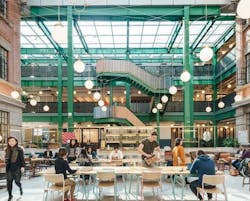At LuxLive 2018, property specialists say they want to see more proof
LONDON — The idea of tuning workplace lighting to varying frequencies that support the human circadian cycle might be catching on in some quarters, but it has yet to win over many potential users, judging by statements from panelists at LuxLive 2018’s Property Technology Live conference here.
“I am cautious of over promising,” said Star Davis, head of lighting for New York City-based shared workspace startup WeWork. Davis was delivering a keynote speech about new work cultures and data-driven smart buildings, when she was asked about the potential for circadian lighting, also known as human-centric lighting or lighting for health and wellbeing.
Like many of the property gurus who expressed reservations, Davis said she was not ruling out the potential for circadian lighting. But for the moment, WeWork, for all of its modern, people-first facilities around the world, does not see enough evidence for its effectiveness, and is running just one pilot at a small meeting room at its home facilities in New York.
Davis said natural light and ceiling height are a priority when it comes to human-centric lighting design.
Matthew Webster, head of wellbeing and future proofing for the UK’s second-largest property company British Land, was equally cautious, noting in a keynote on employee-centric workspaces, that he was simply “not so sure” about the concept.
Likewise, in a panel discussion about the digital workplace, Matthew Marson, head of smart buildings for Montreal-based property engineering giant WSP — associated with London’s Shard — expressed hesitance until the concept is more proven. So did Simon Rawlinson, head of strategic research and insight for Amsterdam-based property engineers Arcadis, who said the firm has yet to advance the notion of circadian lighting.
WeWork prioritizes natural light and ceiling height, such as here at its Shanghai facilities. (Photo credit: WeWork website.)
Even presenters from the lighting industry acknowledged that the field could benefit from more evidence. “Tons of research has to be done,” said David Vanbeselaere, product manager for LED linear modules for Philips OEM, part of Signify, a company that has itself conducted a fair amount of study on the subject. Vanbeselaere was presenting on “how to create a human-centric environment.” Like others throughout the day, he noted the best source of human-centric lighting remains the sun, and he advised people to take outdoor breaks during their workdays.
“There is still research to be done,” said Craig Casey, senior building science engineer for Coopersburg, PA-based lighting controls specialist Lutron in a presentation on “the human side of smart lighting.” Casey said that a lot of human centric lighting boils down to common sense, such as “making sure the buttons are labeled in a way that makes sense.”
Not everyone expressed reluctance. Katie Watkinson, special projects manager for Birmingham, England-based fitness apparel maker Gymshark, said her company has implemented circadian lighting for workers on the customer support teams, which work in shifts from 6 AM until midnight. In a related deployment, Gymshark has also installed tunable lights that let the company check the color appearance of outdoor wear in different potential environments, such as the Australian summer versus the US summer.
As LEDs Magazine has reported many times, circadian lighting is gaining traction, especially in the healthcare field. It has also had its share of deployments in commercial offices, with several notable case studies showing positive impact from human-centric lighting design.
But judging by today’s comments, it still has a long way to go on the road to convincing people.
—
LuxLive2018 and its Property Technology Live conference, chaired by LEDs Magazine’s contributing editor Mark Halper, continues tomorrow.
MARK HALPERis a contributing editor for LEDs Magazine, and an energy, technology, and business journalist ([email protected]).
About the Author

Mark Halper
Contributing Editor, LEDs Magazine, and Business/Energy/Technology Journalist
Mark Halper is a freelance business, technology, and science journalist who covers everything from media moguls to subatomic particles. Halper has written from locations around the world for TIME Magazine, Fortune, Forbes, the New York Times, the Financial Times, the Guardian, CBS, Wired, and many others. A US citizen living in Britain, he cut his journalism teeth cutting and pasting copy for an English-language daily newspaper in Mexico City. Halper has a BA in history from Cornell University.
